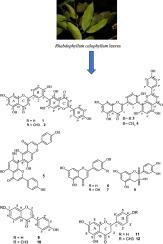来自Rhabdophyllum calophyllum (Hook.f.)叶片的抗菌次生代谢物牡丹科植物牡丹及其化学化学意义
IF 2
4区 生物学
Q4 BIOCHEMISTRY & MOLECULAR BIOLOGY
引用次数: 0
摘要
热带常绿小乔木卡叶横木(Hook.f.)铁(Ochnaceae)被当地人广泛用于制作煎剂,用于治疗常见疾病,如心脏病、胃痛、臀部痛、肋骨痛、疲劳和肠道问题。以往对其乙酸乙酯叶提取物的植物化学研究表明其酚类化合物含量高。本研究报道了从芦花(R. calophyllum, Hook.f.)叶中提取乙酸乙酯的纯化方法。采用柱层色谱和薄层色谱相结合的方法。12个分离化合物的结构通过波谱方法确定,包括1D和2D NMR,红外光谱和高分辨率质谱,并与文献值进行比较。所鉴定的化合物包括鲁棒黄酮(1),7″- o -甲基鲁棒黄酮(2),阿门黄酮(3),7- o -甲基鲁棒黄酮(4),agathisflavone(5),芹菜素(6),木犀草素(7),表儿茶素(8),染料木素(9),异黄酮素(10),柚皮素(11)和angophorol(12)。本文为化合物(1)、(2)、(7)、(9)、(12)的新来源报道。这些分离物对一系列微生物进行了抗菌活性测试,包括弗氏柠檬酸杆菌、阴沟肠杆菌、大肠杆菌、铜绿假单胞菌、伤寒沙门氏菌、粪链球菌、金黄色葡萄球菌、蜡样芽孢杆菌、白色念珠菌、光秃念珠菌和rubrubum小孢子菌。抗菌实验结果显示,7″- o -甲基robustafflavone(2)和7- o -甲基甲烯黄酮(4)活性最高。这些生物活性化合物的存在可以解释横纹草在传统医学中的广泛应用。本文章由计算机程序翻译,如有差异,请以英文原文为准。

Antimicrobial secondary metabolites from the leaves of Rhabdophyllum calophyllum (Hook.f.) Tiegh (Ochnaceae) and their chemophenetic significance
The small evergreen tropical tree Rhabdophyllum calophyllum (Hook.f.) Tiegh (Ochnaceae) is widely used by indigenous people to prepare decoctions for treating common ailments such as heart disease, stomach aches, hip pain, rib pain, fatigue, and intestinal issues. Previous phytochemical studies on its ethyl acetate (EtOAc) leaf extract have revealed a high content of phenolic compounds. This study reports the purification of EtOAc extracts from the leaves of R. calophyllum (Hook.f.) Tiegh using a combination of column and thin-layer chromatography. The structures of 12 isolated compounds were determined using spectroscopic methods, including 1D and 2D NMR, infrared spectroscopy, and high-resolution mass spectrometry, and were confirmed by comparing the data with literature values. The compounds identified include robustaflavone (1), 7″-O-methylrobustaflavone (2), amentoflavone (3), 7-O-methylamentoflavone (4), agathisflavone (5), apigenin (6), luteolin (7), epicatechin (8), genistein (9), isoformonetin (10), naringenin (11), and angophorol (12). This is a new source report for compounds (1), (2), (7), (9), and (12) from the genus Rhabdophyllum. These isolates were tested for antimicrobial activity against a range of microorganisms, including Citrobacter freundii, Enterobacter cloacae, Escherichia coli, Pseudomonas aeruginosa, Salmonella typhi, Streptococcus faecalis, Staphylococcus aureus, Bacillus cereus, Candida albicans, Candida glabrata, and Microsporum rubrum. Antimicrobial assays revealed that 7″-O-methylrobustaflavone (2) and 7-O-methylamentoflavone (4) exhibited the highest activity. The presence of these bioactive compounds may explain the broad use of Rhabdophyllum species in traditional medicine.
求助全文
通过发布文献求助,成功后即可免费获取论文全文。
去求助
来源期刊

Biochemical Systematics and Ecology
生物-进化生物学
CiteScore
3.00
自引率
12.50%
发文量
147
审稿时长
43 days
期刊介绍:
Biochemical Systematics and Ecology is devoted to the publication of original papers and reviews, both submitted and invited, in two subject areas: I) the application of biochemistry to problems relating to systematic biology of organisms (biochemical systematics); II) the role of biochemistry in interactions between organisms or between an organism and its environment (biochemical ecology).
In the Biochemical Systematics subject area, comparative studies of the distribution of (secondary) metabolites within a wider taxon (e.g. genus or family) are welcome. Comparative studies, encompassing multiple accessions of each of the taxa within their distribution are particularly encouraged. Welcome are also studies combining classical chemosystematic studies (such as comparative HPLC-MS or GC-MS investigations) with (macro-) molecular phylogenetic studies. Studies that involve the comparative use of compounds to help differentiate among species such as adulterants or substitutes that illustrate the applied use of chemosystematics are welcome. In contrast, studies solely employing macromolecular phylogenetic techniques (gene sequences, RAPD studies etc.) will be considered out of scope. Discouraged are manuscripts that report known or new compounds from a single source taxon without addressing a systematic hypothesis. Also considered out of scope are studies using outdated and hard to reproduce macromolecular techniques such as RAPDs in combination with standard chemosystematic techniques such as GC-FID and GC-MS.
 求助内容:
求助内容: 应助结果提醒方式:
应助结果提醒方式:


